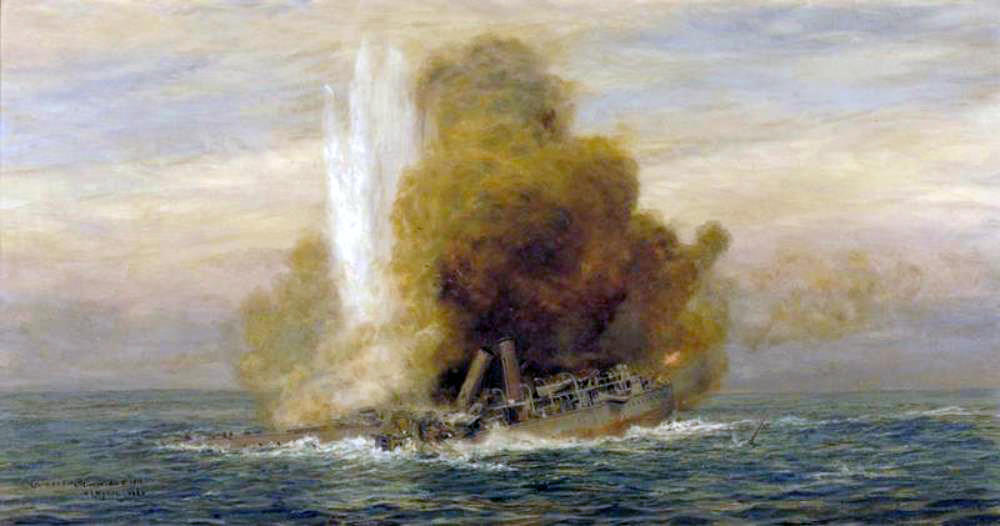Carlingnose Battery – the Guns in Action
| < Controlling Traffic on the Forth | Δ Index | Deeper defences in the Forth > |
Pre-war Exercises
Carlingnose battery was involved in three separate exercises to test the effectiveness of the Forth defences.
[The full accounts are in this Appendix]
The first was in June 1905
An “enemy” fleet attempted to sail up-river to attack the Royal Navy Grand Fleet undergoing a refit in St Margaret’s Bay. The enemy managed to evade the gun batteries and defence lights and succeeded in torpedoing two battleships lying upstream of the Forth Bridge.
The attacking force was a number of torpedo boats:
“They came along by the northern shore, and at a great speed, just like an arrow from the bow or a bird on the wing. For a minute or two they were seen, and then they disappeared, having shot through below the bridge. From the time that the first one was observed till the time that the “cease fire” on the forts was sounded would not occupy more than five minutes.”
[Ironically the submarine mining service had been disbanded in March 1905. If the minefield had been deployed the torpedo boats would have been confined to the “friendly channel” where they would have been easy targets for the gun batteries, or the observations mines.]
1908 – A second test of the defences
While the first exercise and its outcome had been a public spectacle, the second exercise was a more circumspect affairs. The idea was that a defending fleet in the Forth were in need of reinforcements, which would have to break through an enemy fleet which was blockading the Firth.
Based on observation of ship movements, apparently the reinforcements successfully out-manoeuvred the blockading fleet, but there was no official communication about the outcome of the exercise.
In August 1913, a submarine successfully passed all of the defences unobserved
The Fife Free Press of Saturday August 30th 1913 reported:
“The efficiency of the submarine as a fighting unit was (says a correspondent) amply demonstrated in the Forth of Forth the other day. One of that type of vessel left Dundee with the object of testing the coast defences on the way to Rosyth. Not only did it manage to steer stealthily past the Inchkeith batteries, but it was not even noticed by the battleships which were anchored in the vicinity of the Forth Bridge. It reached Rosyth Dockyard, which would have proved a very easy object of attack. Nothing was said of the surprise visit until the submarine had returned safely to its base at Dundee, when intimation was sent to the warships as to what had taken place.”
Shortly after this incident a third exercise to test the defences took place in October 1913
As in the 1905 exercise the objective was for enemy forces to attempt to outrun the gun batteries and defence lights. Carlingnose Battery was an early casualty of the attack as reported in The Courier of Saturday 11th October 1913:
“The first move of the attackers was made shortly after nightfall. It resulted in the Carlingnose Forts being captured in the easiest possible fashion. A body of blue-jackets landed in Burntisland from a torpedo boat and journeyed by train to Inverkeithing.
Arriving there, the “tars,” heavily armed and accoutred, skirted the main streets and succeeded in attracting but little attention.
They avoided the main highway to North Queensferry, and, scrambling over dykes and palings, made their approach to Carlingnose by the Ferry Hills.
Between the land and sea forces there was a pre-arranged scheme, and when the guns began to belch forth their message of war the bluejackets, taking the garrisons in the rear, surprised them.”
This tactic carries echoes of the seizure of the guns during Cromwell’s invasion of 1651 when troops landed behind the guns.
Breakout of World War I
On August 1st 1914 – Germany declared war on Russia
On August 3rd 1914– Germany declared war on France. German Troops implemented the Schlieffen Plan by marching into Belgium. Britain demanded that Germany withdrew from Belgium.
On August 4th 1914- Britain declared war on Germany.
Shortly afterwards, the Carlingnose guns were fired in anger for the first (and last) time.
1914 September – the sinking of HMS Pathfinder
At the beginning of September 1914, the German submarine U-21, ventured into the Firth of Forth, as far as the Carlingnose Battery. At one point the periscope was spotted and the battery opened fire but without success.
Overnight the U-boat left the Forth. On the morning of 5 September, it spotted HMS Pathfinder on patrol near the Isle of May. U-21 fired a torpedo, and despite evasive action from HMS Pathfinder, the torpedo struck the ship beneath the bridge. The detonation apparently set off cordite bags in the forward magazine which caused a second, more massive explosion within the fore section of the ship, essentially destroying everything forward of the bridge. Broken in two, the Pathfinder instantly began sinking, dragging most of her crew down with her and leaving a massive pall of smoke to mark her grave.
The vessel sank so quickly that there was insufficient time to launch lifeboats.
 Loss of HMS Pathfinder, September 5th 1914 by William Lionel Wyllie – Art.IWMART5721
Loss of HMS Pathfinder, September 5th 1914 by William Lionel Wyllie – Art.IWMART5721
Later that month a German U-boat attacked and sank three obsolete Royal Navy cruisers, manned mainly by reservists. Approximately 1,450 sailors were killed and there was a public outcry in Britain at the losses. The sinking damaged the reputation of the Royal Navy, at a time when many countries were considering which side to support in the war.
The success of the submarine was one of the factors that altered the defence strategy in the Forth and spelt the end for the guns at Carlingnose.
| < Controlling Traffic on the Forth | Δ Index | Deeper defences in the Forth > |